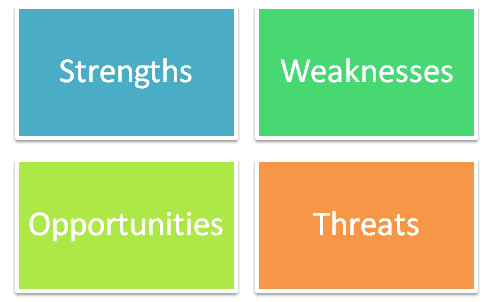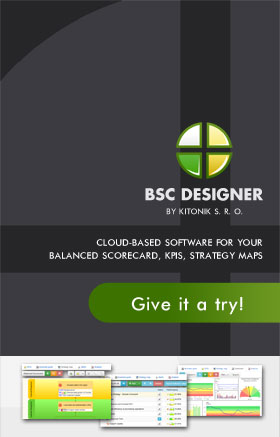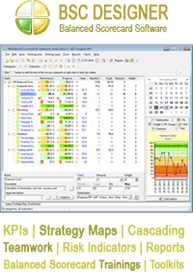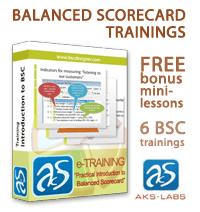SWOT analysis: introduction and use of the method in the business environment
If you are even remotely familiar with a business world, you have certainly heard about the competitive environment, strategic planning and business analysis. There are several different methods currently used in the business world and one of the most popular strategic evaluation tools is the SWOT analysis. SWOT stands for strengths, weaknesses, opportunities, and threats.
SWOT can be further classified in to internal and external factors. Strength and weaknesses belong to the internal factors, and the opportunities and strength are classified as external factors.
Why use SWOT analysis you might ask? Well, it is a very useful and highly effective tool when planning for the strategic goals, when trying to analyze the environment the company operates in, and it is a good visual illustration of the challenges company faces. What is unique about SWOT is that it enables managers and executives to lists the key advantages and disadvantages of the company and matches them with the external factors that will influence the company’s performance in the short and the long run.
To give you a better understanding of the method, let’s look at some of the examples of strength, weaknesses, opportunities and strength.
Strength
- Rights to intellectual property; patents.
- Strong brand.
- High customer satisfaction.
- Cost effective methods in operations.
- Availability of cheap resources.
- Advantage of a highly efficient and effective distribution networks.
Weaknesses
- No patents.
- Weak or no brand developed.
- Low customers satisfaction.
- High cost structure.
- Expensive natural resources.
- Poor distribution networks.
As you have probably noticed, strength and weaknesses are exactly the opposites of each other. It is true in a lot of real cases when the strength for one company is a weakness for another. If one has an access to cheap energy and other company doesn’t, the former has the strength over the latter.
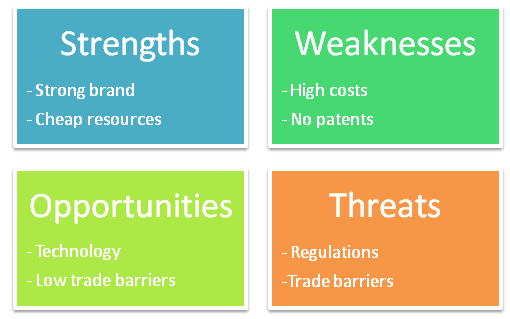
SWOT Analysis. As you have probably noticed, strength and weaknesses are exactly the opposites of each other. It is true in a lot of real cases when the strength for one company is a weakness for another.
Opportunities
- Underutilized customer market; there is a room to grow and generate revenue.
- Modern technologies.
- Relaxed regulations.
- Globalization. Since there are fewer barriers, companies may expand.
Threats
- Changing consumer needs and wants.
- Substitute products and new entrants.
- Regulations.
- Trade barriers.
As you can see, the method can be universally used for almost any condition and environment. It is a tool that can be used in a broader sense and can be as specific as the problem requires it to be.
A simple SWOT analysis graphic is shown below for illustrative purposes.
Stakeholders of the SWOT analysis are several. They are: management, employees, suppliers and distributors, and customers. Let’s not forget that the ultimate goal is to deliver the highest customer satisfaction possible in order to generate revenue and maximize profits. SWOT provides adequate procedures and guidelines for the management to practice. It states clearly the tactics and communication patterns management has to implement in order to achieve the strategic goals. Employees are directed and trained to increase productivity and reduce errors. Suppliers and distributors are considered in order to design highly effective and efficient supply chains and distribution networks; and finally the customer satisfaction and loyalty is one of the most important aspects that SWOT helps to evaluate and plan for.
Who uses the method? SWOT is used by the managers and top executives in the evaluation, planning, and implementation process.
In the evaluation process, top executives review the available resources, measure the revenues and the target cost structures, and once ready, set out a strategic plan that stipulates the direction that company is going to take. In this process, they evaluate all four characteristics and plan for an appropriate course of action.
For the planning process, upper and mid level management reviews the graph, and gets familiar with the key objectives as well as the resources available to them in order to achieve the strategic goals. In the implementation process, thanks to the clear definitions of what is going to affect the company’s performance, employees have the advantage of knowing what to expect and what is going to challenge them. SWOT helps them anticipate the future hurdles and plan appropriately in order to overcome the barriers.
As you can see, SWOT is an illustrative method of business planning and evaluation. It enables the management to clearly identify the advantages and disadvantages they are faced with, and design the realistic goals in order to achieve overall organizational success. Advantage of the method is that it is versatile, it creates clear visual picture of the situation and can be modified and adjusted fairly easily. One of the biggest advantages of the method is that it is very inexpensive and provides highest results per dollar invested in to the analysis.
Cost efficiency and performance effectiveness is one of the reasons why the method has been popular among the business executives sine the 1960s.
The full version of SWOT Guide includes:
- 21 PowerPoint templates for SWOT presentation
- 28 pages SWOT Analysis Guide that includes
- Learn more about Business Analysis Method Toolkit full version
